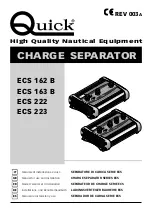
3
Special care must be taken when
installing with a copper system.
Sprinklers must be installed only after
the inside of the sprinkler nipple and
associated fittings have been wire
brushed to remove any flux. Residual
flux can cause corrosion and in
extreme cases can impair proper
sprinkler operation.
Design
Data
In Quick Response applications, Model HEC-12 145
°
F, 160
°
F and 200
°
F rated
sprinklers are intended for standard area coverages and standard flow and
pressure requirements as specified in current NFPA 13 Standards. They are
listed for use in ordinary and light hazard occupancies installed with the
deflector from 4" to 12" below the ceiling.
Design Requirements — Quick Response Applications
* Teflon is a trademark of the DuPont Corp.
Care &
Maintenance
Sprinklers must be handled
carefully. They must not be
transported or stored where ambient
temperatures may exceed 100
°
F/
38
°
C. For best results, store them in
a cool, dry location in the original
shipping package.
Do not install sprinklers that have
been dropped or visibly damaged.
Sprinklers must never be painted,
coated, plated, or altered in any other
way from manufactured condition or
they may not function properly. Any
sprinklers altered in such manner
must be replaced.
The owner is responsible for the
proper working condition of all fire
protection devices and accessories.
The NFPA Standard 25 entitled,
“Inspection, Testing and Maintenance
of Water-Based Fire Protection
Systems”, contains guidelines and
minimum maintenance requirements.
Furthermore, the local
Authority
Having Jurisdiction may have
additional regulations and
requirements for maintenance,
testing, and inspection that must be
obeyed.
It is advisable to have sprinkler
systems inspected regularly by a
qualified inspection service. Length
of time between such inspections can
vary due to accessibility, ambient
atmosphere, water supply, and site
activity.
Do not attempt to re-assemble or
otherwise reuse a sprinkler that has
operated. Replace any sprinkler
exhibiting corrosion or damage;
always use new sprinklers of the
same type and temperature rating as
replacements.
Installation
Model HEC-12 sprinklers must be
installed in accordance with current
NFPA 13 Standards. Deviations from
these requirements and standards or
any alteration to the sprinkler itself
will void any warranty made by
Central Sprinkler Company. In
addition, installation must also meet
local government provisions, codes,
and standards as applicable.
The system piping must be properly
sized to ensure the minimum required
flow rate from the sprinkler.
Prior to installation, check for
proper model, style, orifice size, and
temperature rating. Install sprinklers
after the piping is in place to avoid
mechanical damage; replace any
damaged unit. Wet pipe systems
must be protected from freezing.
Upon completion of the installation,
the system must be tested per
recognized standards.
In the event of a thread leak,
remove the unit, apply new pipe joint
compound or tape, and reinstall.
Installation Sequence
Step 1. The unit must be installed in
the horizontal position.
Step 2. The face of the sprinkler
fitting should be installed 1" (
±
1/8")
behind the finished wall line.
Adjustments are made via the
adjustable sliding escutcheon plate to
compensate for variations in the
fittings.
The sprinkler will function properly,
only when the system piping is
anchored to the building structure.
Otherwise, reaction forces from
system initiation could alter the
sprinkler alignment and disrupt the
distribution pattern.
Step 3. Use only a non-hardening
pipe joint compound or Teflon* tape.
Apply to the male threads only.
Step 4. Hand tighten the sprinkler
into the fitting. Use an Omega HEC
sprinkler wrench to tighten the
assembly into the fitting. A leak tight
joint requires the application of only
7-14 ft.-lbs. of torque. A tangential
force of 14-28 lbs. delivered through
a 6" long rachet handle will deliver
adequate torque. Torque levels over
21 ft.-lbs may distort the orifice seal,
resulting in leakage.
Step 5. To install the escutcheon
plate, align it with and press it over
the sprinkler body until the outer edge
of the escutcheon meets the
mounting surface.
Do not over or under tighten the
sprinkler to compensate for
inaccurate escutcheon plate
adjustment.
Caution: Special care must be
taken when installing with a CPVC
system. Sprinklers must be installed
after the CPVC manufacturer's
recommended setting time for the
primer and cement to ensure that
neither accumulate within the
sprinkler.
OBSOLETE






















